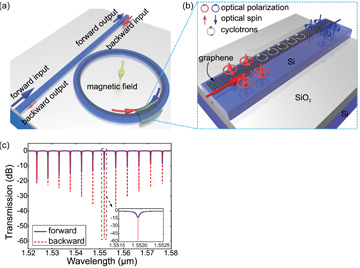 (a) Proposed hybrid graphene/silicon integrated optical isolator consisting of a photonic bus waveguide and a microring resonator. A patterned graphene nanoribbon covers the inner top surface of the silicon waveguide of the microring. (b) Zoomed-in section of the isolator, showing mechanism of the nonreciprocal optical transmission. (c) Calculated forward and backward light transmission spectra of the proposed device at temperature of 77 K and magnetic field of 8.4 T.
(a) Proposed hybrid graphene/silicon integrated optical isolator consisting of a photonic bus waveguide and a microring resonator. A patterned graphene nanoribbon covers the inner top surface of the silicon waveguide of the microring. (b) Zoomed-in section of the isolator, showing mechanism of the nonreciprocal optical transmission. (c) Calculated forward and backward light transmission spectra of the proposed device at temperature of 77 K and magnetic field of 8.4 T.
Optical isolators are a type of non-reciprocal device that allow for unidirectional light transmission by breaking time-reversal symmetry.1 In traditional optics, such devices can easily be implemented using the Faraday rotation effect of magneto-optical garnets. Incorporating isolators into an integrated platform poses problems, however, because of the large lattice mismatch and thermal incompatibility between the magneto-optical garnets and the substrate.
Graphene, a monolayer of carbon atoms, exhibits an enormous magneto-optical effect that can be utilized to construct optical isolators.2 To date, most graphene-based optical isolators have employed an out-of-plane scheme, with light propagating in a direction normal to the graphene sheet.3,4 This scheme not only suffers from a short interaction length, but also is difficult to implement in planar photonic circuits on a chip, where light propagates in parallel with the graphene sheet.
This year, we proposed a hybrid integrated graphene/silicon isolator by exploiting photonic spin–orbit coupling together with graphene’s magneto-optical effect.5 Owing to the photonic spin–orbit interaction, the magnetically induced cyclotrons in the graphene nanoribbon experience different photonic spin for light propagating in opposite directions. As a result, graphene’s magneto-optical property induces a difference in the effective refractive index of the forward- and backward-propagating light, causing the non-reciprocal transmission spectrum required for an optical isolator. An optical micro-ring cavity resonantly enhances the non-reciprocal effect (see figure).
A large extinction ratio can be achieved in the transmission spectra at a resonant wavelength under the critical-coupling condition. At a temperature of 77 K and magnetic field of 8.4 T, our proposed device can achieve an extinction ratio of roughly 45.3 dB, with a reasonable insertion loss of around 12.3 dB, at a wavelength of 1552 nm. Such integrated non-reciprocal devices based on 2-D materials should find great promise and numerous applications in next-generation on-chip photonic systems.
Researchers
Jingwen Ma, Xiang Xi, Zejie Yu and Xiankai Sun (xksun@cuhk.edu.hk), The Chinese University of Hong Kong, Hong Kong SAR, China
References
1. D. Jalas et al. Nat. Photon. 7, 579 (2013).
2. I. Crassee et al. Nat. Phys. 7, 48 (2011).
3. N. Ubrig et al. Opt. Express 21, 24736 (2013).
4. H. Da and C.-W. Qiu. Appl. Phys. Lett. 100, 241106 (2012).
5. J. Ma et al. Appl. Phys. Lett. 108, 151103 (2016).
